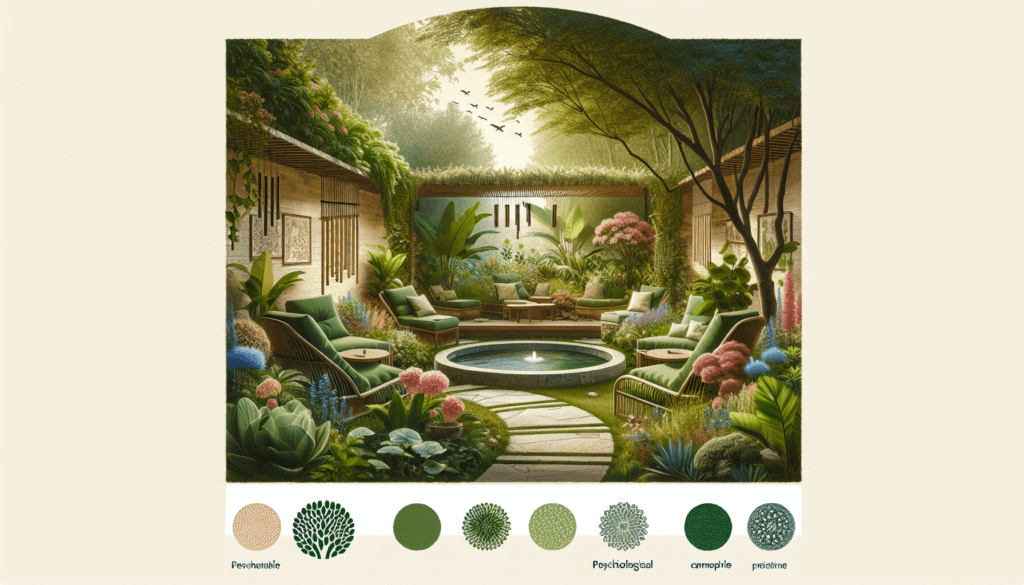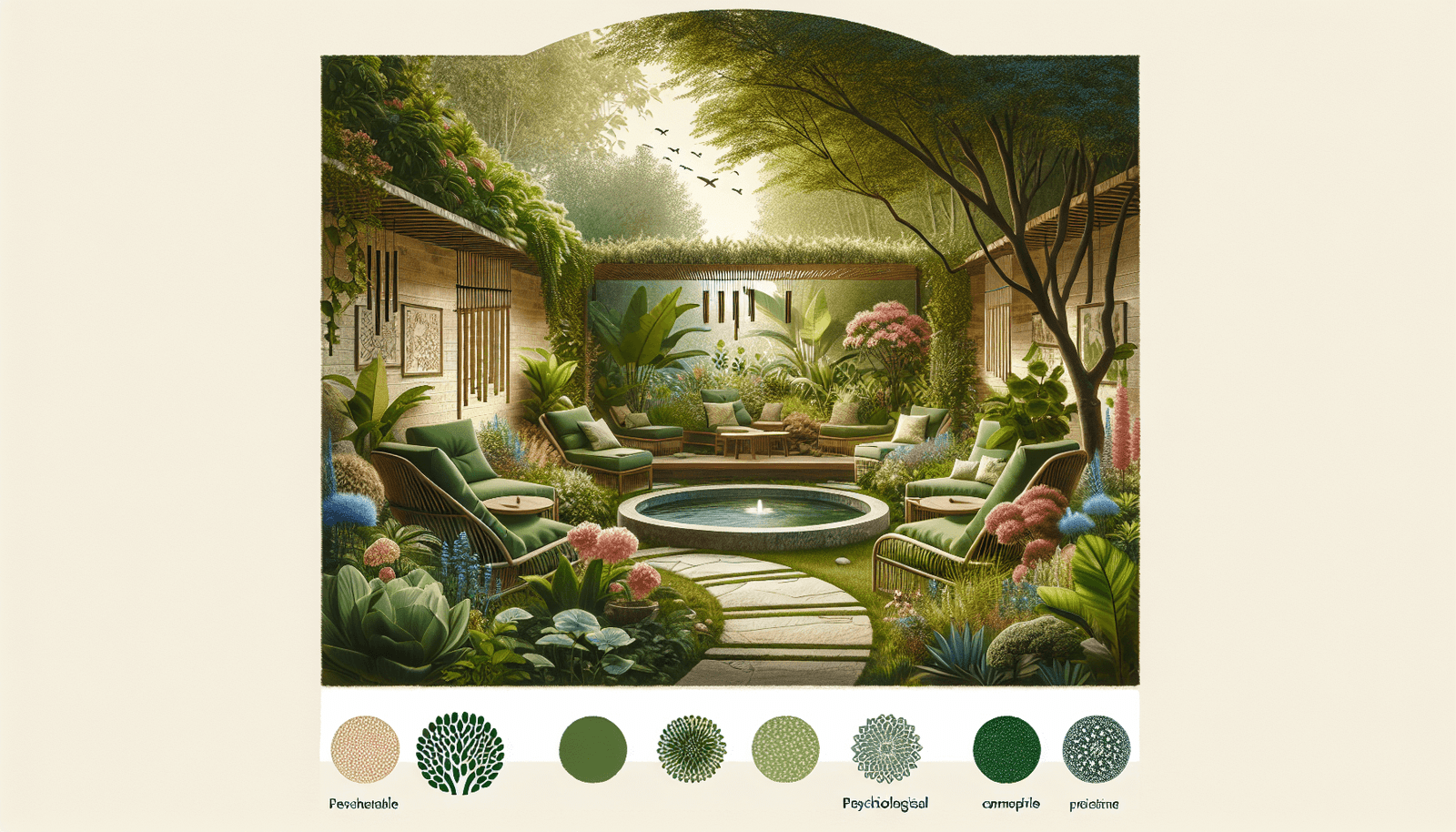Imagine stepping into your lush, green eco-friendly garden and feeling an immediate sense of tranquility wash over you. In this article, you will discover the secrets to creating a psychological comfort zone within your garden space. By understanding the power of nature’s healing touch and implementing simple design principles, you can transform your outdoor oasis into a sanctuary that rejuvenates your mind, body, and soul. Get ready to step into a world where peace and serenity flourish amidst the vibrant colors and smells of Mother Nature’s finest creations.

Choosing the Right Plants
Selecting Native Plants
When choosing plants for your eco-friendly garden, it is important to consider selecting native plants. Native plants are adapted to the local climate and soil conditions, making them more resilient and less reliant on artificial interventions such as pesticides and fertilizers. Additionally, native plants provide essential habitat and food sources for local wildlife. By choosing native plants, you can create a garden that not only thrives but also supports the local ecosystem.
Considering Plants with Soothing Scents
Another aspect to consider when choosing plants for your garden is their scent. Certain plants, such as lavender, jasmine, and roses, have soothing and calming scents that can promote relaxation and reduce stress. By incorporating plants with pleasant fragrances, you can create a sensory experience that enhances your psychological comfort in the garden. Consider planting these scented plants near seating areas or along pathways to fully enjoy their aromatic qualities.
Including Plants with Soft Textures
In addition to selecting native plants and those with soothing scents, it is beneficial to include plants with soft textures in your garden. Plants with velvety leaves, feathery fronds, or fuzzy stems can engage your sense of touch and create a tactile experience. This can be especially helpful for individuals seeking a tactile escape or those who find comfort in the sensation of different textures. Consider incorporating plants such as lamb’s ear, ferns, or ornamental grasses to provide a variety of soft textures in your garden space.
Creating Privacy
Installing Natural Barriers
Privacy is an essential aspect of creating a psychological comfort zone in your garden. To create a sense of seclusion and privacy, consider installing natural barriers such as hedges or tall shrubs. These plants not only provide a visual separation from the surrounding area but also act as natural sound barriers, helping to reduce noise from neighboring properties or busy streets. By strategically placing these natural barriers, you can transform your garden into an intimate oasis that feels secluded and tranquil.
Utilizing Tall Plants or Trellises
Another way to enhance privacy in your garden is by utilizing tall plants or trellises. Tall plants, such as bamboo or ornamental grasses, can create a wall-like effect, shielding your garden from prying eyes. Additionally, trellises covered with climbing plants, such as ivy or climbing roses, can create a beautiful and natural screen while adding vertical interest to your garden. These vertical elements not only provide privacy but also create a sense of enclosure and intimacy within your outdoor space.
Strategically Placing Furniture or Structures
To further enhance privacy in your garden, consider strategically placing furniture or structures. By positioning seating areas or outdoor structures, such as pergolas or gazebos, in secluded corners of your garden, you can create hidden retreats. These private spaces can serve as tranquil sanctuaries where you can relax, unwind, and escape from the pressures of everyday life. By consciously considering the placement of these elements, you can maximize both privacy and comfort in your garden.

Promoting Relaxation
Designing Cozy Seating Areas
Promoting relaxation in your garden can be achieved through thoughtful design of cozy seating areas. Look for comfortable outdoor furniture with plush cushions or cozy hammocks where you can recline and unwind. By providing comfortable seating options, you create a space where you can fully relax and enjoy the tranquility of your garden. Arrange these seating areas in shaded locations or under dappled sunlight to ensure a comfortable and inviting atmosphere.
Incorporating Water Features
Water features are known for their calming and soothing qualities, making them a fantastic addition to any garden aiming to promote relaxation. The sound of flowing water can drown out background noise, creating a peaceful ambience. Consider incorporating features such as a bubbling fountain, a peaceful pond, or a gentle stream. These water elements not only provide auditory tranquility but also add visual interest and create a sense of serenity.
Using Relaxing Colors in the Garden
Colors can have a significant impact on our mood and emotions, so it is important to consider using relaxing colors in your garden. Colors such as soft blues, soothing greens, and calming purples can evoke feelings of peace and tranquility. By selecting plants with flowers or foliage in these calming colors, you can create a visually harmonious and restful environment. Additionally, consider adding elements such as colored cushions, decorative pots, or garden accessories in these relaxing hues to further enhance the overall ambiance.
Reducing Noise
Planting Trees or Shrubs as Sound Barriers
Noise pollution can significantly impact our psychological comfort, especially when we seek solace in our gardens. To mitigate noise, consider planting trees or shrubs as sound barriers along the perimeter of your garden. Dense evergreen trees, such as Leyland cypress or Thuja, can effectively block out noise and create a buffer between your garden and surrounding areas. By carefully selecting and positioning these sound-barrier plants, you can create a quieter and more peaceful outdoor space.
Installing a Water Fountain or Bird Bath
As mentioned earlier, water features offer not only visual and auditory beauty but also a solution for reducing noise. By installing a water fountain or bird bath, you introduce the sound of flowing water into your garden environment. The gentle sounds of water can help mask unwanted noise and create a more serene atmosphere. The tinkling sound of a fountain or the gentle splashing of a bird bath can have a calming effect on the mind, allowing you to relax and enjoy your garden in peace.
Adding Sound Absorbing Materials
In addition to natural methods of noise reduction, you can also incorporate sound-absorbing materials into your garden design. By adding elements such as outdoor rugs, canvas wall hangings, or fabric curtains, you can help absorb and dampen sound, reducing the overall noise level in your garden. These materials not only serve a functional purpose but can also add aesthetic charm to your outdoor space. Choose materials that are designed for outdoor use and can withstand the elements to ensure longevity and durability.

Creating a Harmonious Layout
Applying the Principles of Feng Shui
Feng Shui is the ancient Chinese practice of creating harmonious and balanced environments. Applying principles of Feng Shui in your garden design can help create a sense of peace and equilibrium. Start by considering the flow of energy, or “chi,” in your garden. Ensure that pathways are clear and unobstructed, allowing for a smooth and uninterrupted flow. Incorporate elements of balance, such as symmetrical plantings or a focal point at the center of your garden. By consciously designing your garden with these principles in mind, you can create a tranquil and harmonious space.
Balancing Visual Elements
In addition to considering the principles of Feng Shui, it is important to balance visual elements in your garden. Consider the distribution of colors, shapes, and textures throughout your outdoor space. Avoid overwhelming one area with too much visual stimulation and instead strive for a cohesive and balanced design. Incorporate a variety of plants with different heights, textures, and colors to create visual interest while maintaining a sense of harmony. By achieving a balanced and pleasing visual composition, you can create a garden that is aesthetically pleasing and psychologically comforting.
Creating Flow with Pathways
Pathways play a crucial role in the overall layout and design of your garden. They not only provide a physical connection between different areas but also help create a sense of flow and harmony. Consider using materials such as natural stone, gravel, or wooden boards to create pathways that seamlessly blend into the surrounding environment. Curved pathways can add a sense of movement and invite exploration, while straight paths can provide a clear and direct route. By carefully designing and constructing your pathways, you can create a garden that is easy to navigate and visually appealing.
Attracting Wildlife
Including Bird Feeders or Birdbaths
One way to create a vibrant and dynamic garden is by attracting wildlife. Birds, in particular, can bring life and energy to your outdoor space. To attract birds to your garden, consider installing bird feeders or birdbaths. These features provide a reliable food and water source, encouraging birds to frequent your garden. Choose feeders and birdbaths that are suitable for the local bird species, and position them in a visible and accessible location. By creating a welcoming environment for birds, you can enjoy the sights and sounds of these beautiful creatures while also contributing to their well-being.
Planting Flowers that Attract Butterflies
Butterflies are another delightful addition to any garden. Their colorful wings and delicate flight patterns can bring joy and a sense of wonder. To attract butterflies to your garden, consider planting flowers with nectar-rich blooms. Flowers such as lavender, coneflowers, and milkweed are known to attract butterflies. Additionally, provide host plants that support butterfly larvae, such as dill or parsley for swallowtail butterflies. By creating a butterfly-friendly garden, you not only benefit from their presence but also contribute to the conservation of these important pollinators.
Providing Water Sources for Wildlife
In addition to attracting birds and butterflies, it is important to provide water sources for a variety of wildlife. Installing a small pond, a shallow basin, or a bubbling rock fountain can provide a water source for birds, frogs, and other small creatures. Ensure that the water feature has a gentle slope or rocks for easy access and exit, and consider adding floating plants or water lilies for additional beauty and habitat. By providing water sources, you can create an ecosystem in your garden that supports a diverse range of wildlife.

Designing for All Senses
Incorporating Fragrant Flowers and Herbs
Designing a garden that engages all of your senses can enhance the overall psychological comfort of the space. To stimulate the sense of smell, incorporate fragrant flowers and herbs into your garden. Consider plants such as roses, jasmine, or lavender for their delightful scents. Additionally, herbs such as mint, thyme, or basil can release tantalizing fragrances when brushed against or crushed. By selecting and placing these scented plants strategically, you can create a garden that is a feast for the senses.
Adding Texture with Various Materials
In addition to fragrance, the sense of touch plays a significant role in our psychological comfort. Incorporate different materials with varying textures throughout your garden to engage the sense of touch. Use materials such as smooth stones, rough bark, or moss-covered logs to create interesting tactile experiences. Add elements such as benches made of teak or wicker, which offer both visual and tangible texture. By introducing a variety of textures, you enhance the sensory experience of your garden and create a more compelling and inviting space.
Including Wind Chimes or Musical Elements
Sound can also be an important element in creating a sensory experience in your garden. Wind chimes or other musical elements, such as bamboo tubes or small bells, can add a gentle and melodic sound to your outdoor space. The soft tinkling or soothing melodies produced by these instruments can create a sense of tranquility and relaxation. Select chimes with different shapes and sizes to produce a harmonic and pleasing sound. By including these musical elements, you not only engage the sense of hearing but also add a touch of whimsy and charm to your garden.
Adding Personal Touches
Decorating with Personal Mementos
To create a garden that truly reflects your personality and brings you joy, consider decorating with personal mementos. Display items such as vintage garden tools, inherited sculptures, or shell collections that hold sentimental value. These personal touches add a sense of history and uniqueness to your garden while evoking cherished memories. Showcase these mementos in prominent locations or create small vignettes throughout your garden to enjoy and appreciate their significance.
Integrating Art or Sculptures
Art can bring a new dimension of beauty and creativity to your garden. Consider integrating sculptures, pottery, or garden art pieces that resonate with your personal taste and style. Choose pieces that are weather-resistant and can withstand the outdoor elements. Sculptures can serve as focal points or points of interest, drawing the eye and creating visual intrigue. By carefully selecting and placing art in your garden, you can infuse your outdoor space with your own artistic expression and create a visually captivating environment.
Displaying Inspirational Quotes or Signs
Inspirational quotes or signs can add a touch of positivity and motivation to your garden. Consider displaying favorite quotes or uplifting messages in weather-resistant frames or as engraved stones. Position these thoughtful messages in areas where you can easily see them while enjoying your garden. These words of wisdom or encouragement can serve as a daily reminder to find peace, joy, and inspiration within your outdoor sanctuary.

Managing Garden Maintenance
Designing an Efficient Watering System
Efficiently managing garden maintenance can contribute to your overall psychological comfort. Designing an efficient watering system is essential for a healthy and thriving garden. Consider installing drip irrigation systems or soaker hoses to deliver water directly to plant roots while minimizing water waste through evaporation. This ensures that your plants receive the necessary hydration while conserving water. Additionally, consider incorporating rainwater harvesting systems, such as rain barrels or underground tanks, to collect and utilize rainwater for your garden’s irrigation needs.
Utilizing Mulch for Weed Control
To reduce the time and effort spent on weed control, utilize mulch in your garden. Mulching not only helps suppress weed growth but also conserves moisture in the soil. Consider using organic mulches, such as wood chips or shredded bark, that decompose over time and enrich the soil. Apply a thick layer of mulch around your plants and in garden beds, ensuring that the mulch does not touch the plant stems to prevent rot. By incorporating mulch into your garden maintenance routine, you can create a tidy and weed-free space with minimal effort.
Maintaining a Neat and Organized Space
Maintaining a neat and organized garden can contribute to your overall psychological well-being. Develop a regular maintenance routine that includes tasks such as deadheading flowers, pruning shrubs, and removing debris. Store gardening tools in a designated area, such as a shed or a tool rack, to keep the garden tidy and clutter-free. Regularly clean and sweep pathways, patios, and seating areas to create a clean and inviting space. By staying on top of maintenance tasks, you can ensure that your garden remains a peaceful and welcoming retreat.
Continual Improvement
Seeking Feedback from Family and Friends
Continual improvement is key to creating a psychological comfort zone in your eco-friendly garden. Seek feedback from family and friends who visit your garden and ask for their thoughts on its design, layout, and overall ambiance. Their fresh perspective may reveal insights and ideas that you may not have considered. Use their feedback as an opportunity to make changes and improvements, ensuring that your garden continues to evolve and meet your needs.
Experimenting with Different Plants or Features
Don’t be afraid to experiment with different plants or features in your garden. Gardening is a creative process, and trying new things can lead to exciting discoveries. Consider introducing new plants or flowers each season to add variety and interest. Experiment with different garden structures, such as arches or pergolas, to create focal points and a sense of intrigue. By embracing experimentation, you can continuously improve and refine your garden, making it a reflection of your evolving taste and style.
Applying Lessons Learned from Successful Gardens
Learn from successful gardens and apply those lessons to your own space. Visit botanical gardens or attend gardening workshops to gather inspiration and ideas. Take note of design principles or techniques that resonate with you and adapt them to your own garden. Notice how other gardeners have achieved balance, harmony, and comfort in their outdoor spaces. By learning from the success of others, you can infuse your garden with new ideas and strategies that enhance its psychological comfort.
Creating a psychological comfort zone in your eco-friendly garden requires thoughtful planning, consideration, and an understanding of your personal preferences. By selecting the right plants, creating privacy, promoting relaxation, reducing noise, and designing for all senses, you can create a garden that nourishes your mind, body, and soul. Incorporate personal touches and continually improve your garden through experimentation and learning from other successful gardens. With time and dedication, your eco-friendly garden will become a sanctuary of tranquility and a source of comfort for years to come.


